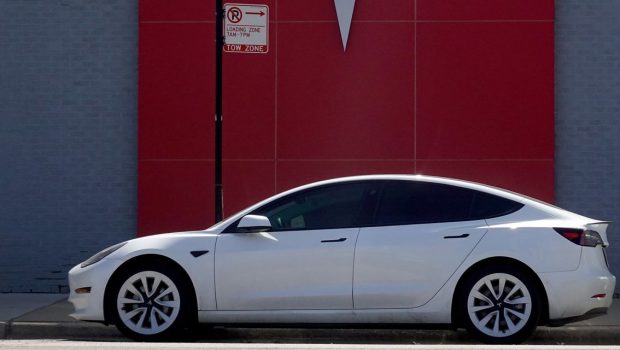Text size
A Tesla car at a dealership in Chicago.
Scott Olson/Getty Images
Bernstein analyst Toni Sacconaghi believes
Tesla
bulls have a flaw in their thinking. They believe the company will be able to generate higher profit margins by adding technology to its cars and charging customers for it, he asserts.
Sacconaghi—a longtime
Tesla
(ticker: TSLA) bear—isn’t so sure that’s how things will develop for Tesla. He points out that car prices have historically trailed gains in the overall consumer price index. Customers, it appears, don’t like to pay for innovation. They expect it. He has a point, but the pricing data for cars is, frankly, fraught.
Tesla stock was up 0.7%, at $1,107.32, in recent trading. The S&P 500 and Dow Jones Industrial Average were down 0.3% and 0.2%, respectively.
Between 2012 and 2020, just before pandemic struck, the average price of a new car, according to the government, increased 0.3% a year on average. The average price of a used car decreased at 1% a year on average over the same span. The overall CPI averaged an annual increase of about 1.7% during that period.
That means new and used cars, on balance, got cheaper. That’s a revelation to anyone buying a car. The base price of a Honda Accord back in 2012 was roughly $21,500. The base price of an Accord in 2020 was roughly $25,000. That’s an increase of about 16%, or almost 2% a year on average.
How can those numbers all be accurate? The government makes “hedonic” adjustments when calculating the CPI. That means they take into consideration how much better the 2020 Accord is relative to the 2012 Accord. Maybe antilock brakes are now standard, or maybe the sound system is better quality. Improving technology generates a kind of pricing credit.
The government makes the same kind of adjustments for anything the CPI, which means hedonic adjustments create a disconnect between CPI data and consumer experience.
The falling-car-price trend is dean now, now matter which math anyone uses. From January 2020 to January 2022, used-car prices inflated at an average 24% a year, according to CPI data. New-car prices rose at an average annual rate of about 7% over that span.
Customer experience matches up more closely with those numbers. People are paying above sticker price for cars today. That’s a new experience for car buyers used to haggling for a deal. A survey of 1.2 million new-car listings from iseecars.com showed the average markup over the manufacturer suggested retail price was almost 10%.
The Jeep Wrangler saw a price adjustment over sticker of almost $9,000, or 27%. Tesla didn’t make the iseecars list-price survey because Tesla sells direct to consumers. There is never any difference between the MSRP and what consumers pay.
For now, investors can look at Tesla profit margins, which are impressive. Operating profit margins, excluding regulatory credit sales, in the fourth quarter of 2021 came in at roughly 13%. Operating profit margins for
General Motors
(GM) were about 5% in the same quarter.
Sacconaghi, for his part, rates Tesla shares Sell and has a $450 price target for the stock. At his target price, Tesla would still be the world’s most-valuable car company by a wide margin.
Write to Al Root at allen.root@dowjones.com








Gloss